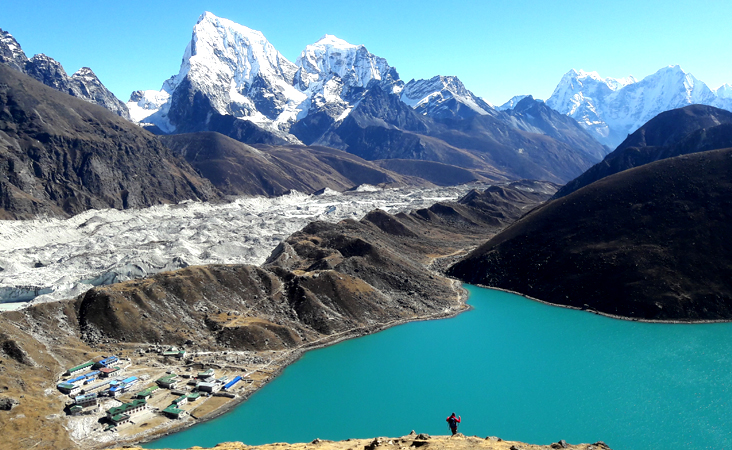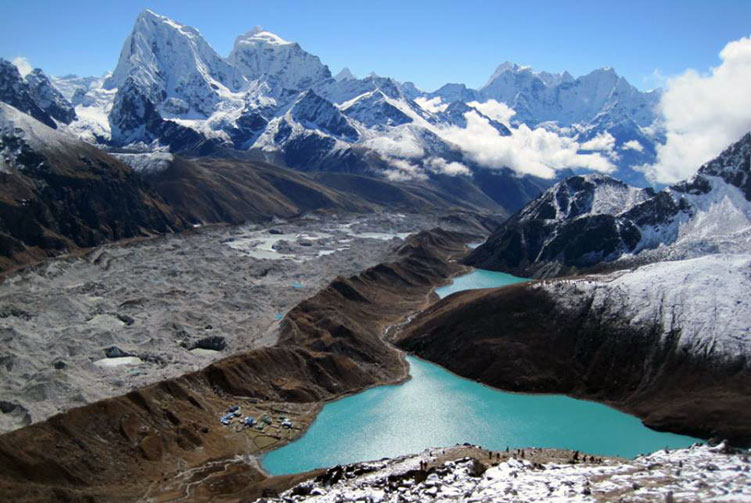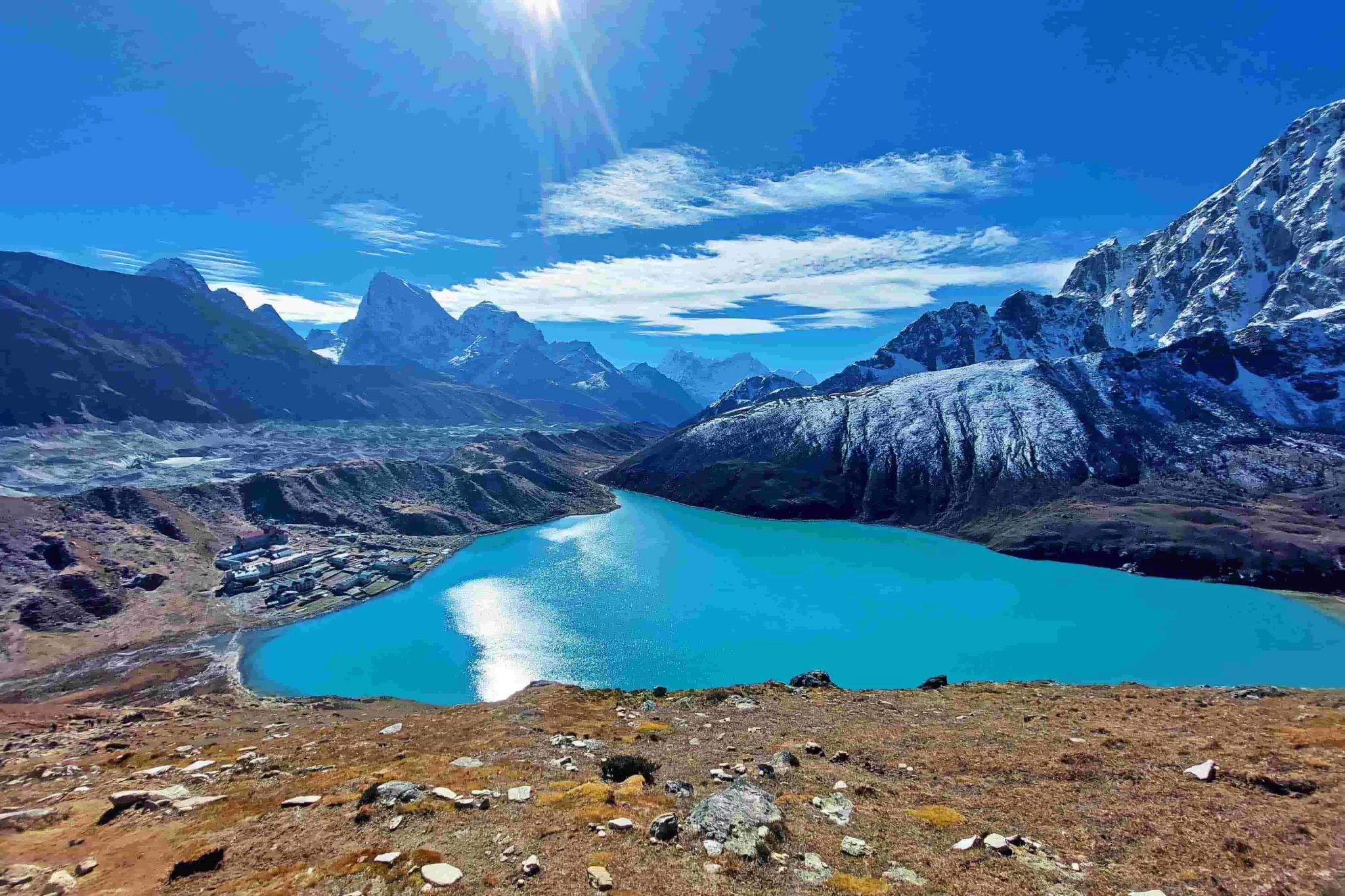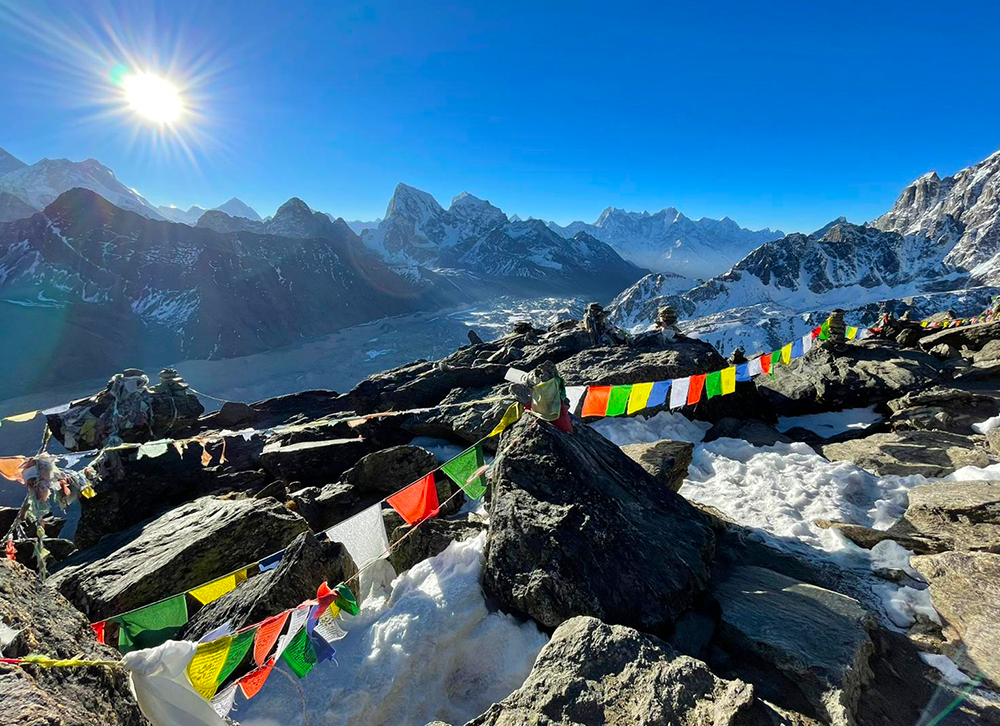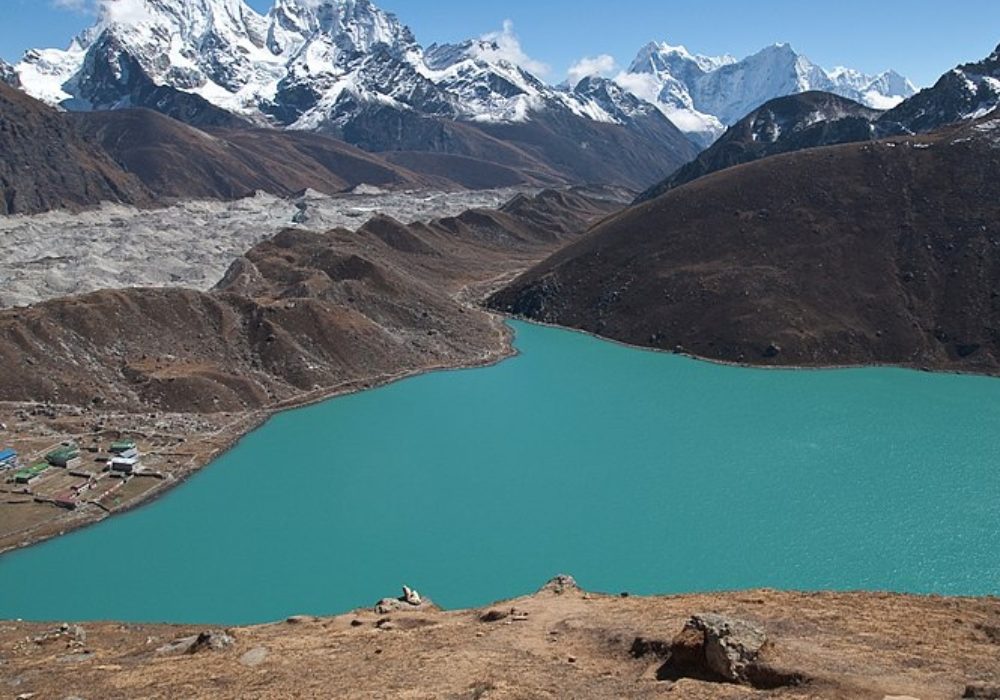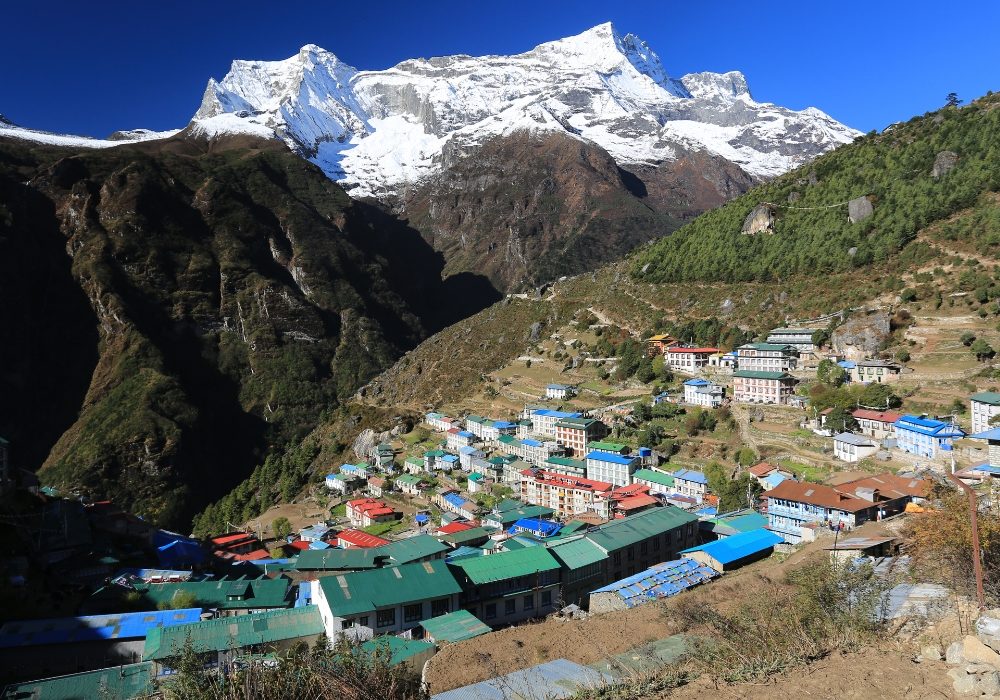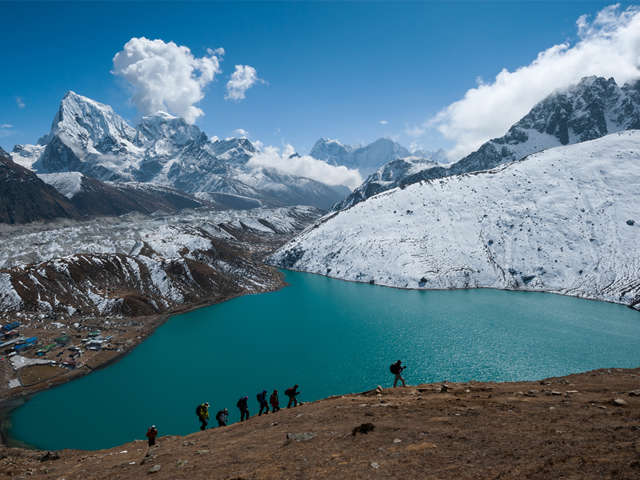Gokyo Ri and Gokyo Lake Trek
Trip Overview
Gokyo Ri and Gokyo Lake Trek
The Gokyo Ri and Gokyo Lake Trek is a spectacular journey through the Everest region of Nepal, offering an alternative route to the classic Everest Base Camp trek. In this 12 to 14-day adventure, trekkers will treat breathtaking views of the Himalayas, including the majestic Mount Everest, as well as the opportunity to explore the stunning Gokyo Lakes.Natural Beauty
The trek begins with a scenic flight from Kathmandu to Lukla, a small town in the Khumbu region. From Lukla, the trail gradually ascends through picturesque Sherpa villages, lush valleys, and dense forests of rhododendron and pine. Along the way, trekkers can also experience the unique Sherpa culture and visit ancient monasteries, gaining insight into the local way of life.Highlights of Gokyo Ri Trek
One of the highlights of the trek is the ascent of Gokyo Ri, a peak standing at an impressive altitude of 5,357 meters (17,575 feet). From the summit, adventurers also rewards panoramic views of some of the world's highest peaks, including Everest, Lhotse, Makalu, and Cho Oyu. The sight of the sun rising over these majestic mountains is truly awe-inspiring and an experience not to be missed.Highlights of Gokyo Lakes Trek
Another enchanting aspect of the trek is the Gokyo Lakes, a series of six sparkling turquoise lakes nestled amidst the Himalayan peaks. These sacred lakes hold great religious significance for both Hindus and Buddhists and provide a serene and tranquil setting for trekkers to relax and soak in the natural beauty.Acclimatization for Journeys
Throughout the journey, trekkers will also encounter rugged mountain trails, steep ascents, and descents, adding an element of adventure and challenge. Altitude acclimatization is crucial, with scheduled rest days to allow the body to adjust to the high elevations.Accomodations and Meals for Gokyo Ri and Gokyo Lake Trek
Accommodation along the route is available in teahouses and lodges, providing basic amenities such as beds and communal dining areas. The trek also offers opportunities to taste local cuisine, including dal bhat (lentil soup with rice) and momos (steamed dumplings), providing a taste of traditional Sherpa fare.Conclusion and Summary of Gokyo Ri and Gokyo Lake Trek
The Gokyo Ri and Gokyo Lake Trek is also an unforgettable journey through the heart of the Everest region, offering a unique perspective on the world's highest peaks and a chance to immerse oneself in the rich Sherpa culture. With its stunning landscapes, spiritual lakes, and breathtaking mountain vistas, this trek is a must-do for adventure seekers and nature lovers alike.Trip Highlight
- Thrilling flight to Lukla (the starting point) with dramatic aerial views of the Himalayas
- Walkthrough the Sagarmatha National Park, crossing many suspension bridges and beautiful small villages
- Less crowded, adventurous trek route to the stunning Gokyo Valley
- Acquaint yourself with the culture and traditions of the friendly Sherpa people
- Most Dangerous Airport of the world in Lukla
- One of the world’s highest airports in Syangboche (3,780m)
- Explore Sagarmatha national park – UNESCO World Heritage Site
- Wide range of flora and fauna
- Wildlife like musk deer, colorful pheasants, snow leopard, and Himalayan tahr
- Climb to the high-altitude Gokyo Lakes and enjoy stunning mountain views
- Gaze upon the magnificence of world-class mountains like Mt. Everest (8,848m) Mt. Lhotse (8,516m), Cho Oyu (8,201m) and Mt.Makalu (8,463m)
- Stone houses and meadows around Gokyo Valley
- Hiking to Everest View Hotel for breathtaking mountain vistas.
- Trekking through rhododendron forests and yak pastures towards Dole.
- Ascend to the peak of Gokyo Ri (5,360 meters) for unforgettable panoramic views of the Himalayas
- Stand at the shores of a chain of six turquoise, glacial-fed lakes
- Hike along Ngozumpa Glacier, the largest glacier in the Himalaya
- Avoid the Everest crowds, but enjoy the selection of great views
- Witness breathtaking views of the snow-capped mountains, glaciers, and valleys
- Pass by chortens, prayer wheels, stupas, high suspension bridges and colorful prayer flags
- Get to see the daily lifestyle of Sherpas and other mountain people from different communities
- Explore picturesque Gokyo villages and lovely Gokyo Lakes
- Sampling delicious Sherpa cuisine and local delicacies during the trek.
- Admiring the architecture and intricacies of Sherpa villages.
- Experiencing the rhythm of mountain life and daily activities of the locals.
- Capturing unforgettable memories against the backdrop of towering peaks and serene lakes.
- Reflecting on the achievement of completing one of the most scenic treks in the Everest region.
- Trek through the Sherpa town of Khumjung, home of a ‘real’ yeti skull
- Trek with a team of highly experienced guides who have more than two decades of experience organizing treks in the Himalayas
Itinerary
Upon our arrival at Tribhuwan International Airport in Kathmandu, we will be warmly greeted by a representative from Friendship World Trek. After completion of our custom formalities (Visa, etc), we pick up our luggage and look for our representative with Friendship World Trek display board at the arrival gate. We will be then escorted to Hotel. After check in, where we meet with our trekking guides or hangs around the city. At the evening upon our reception, Friendship World Trek will organize a Welcome Dinner at an excellent traditional Nepalese restaurant where we enjoy a Nepalese cultural program as well as a fine meal. Included meal: Dinner (D)
Today after breakfast we start a guided tour to several of the most historical and spiritual attractions in Kathmandu. Some of these landmarks are considered World Heritage Sites; including the historic Durbar Square, the sacred Hindu temple of Pashupati Nath, the famous ‘Monkey Temple’ (Swayambhunath) and Buddhists shrine (BouddhaNath) which is one of the large Stupas in the world. At the noon, there will be a pre-trip discussion where we can meet our trek leader and other team members. Friendship World Trek briefs us regarding our trek as well as provides us opportunity to ask any questions we may have regarding our upcoming adventure. Over night at Kathmandu. Included meal: Breakfast (B)
After breakfast, we will be escorted to the domestic terminal of Kathmandu airport for an early morning flight to Lukla (2,800m/9,186ft), a gateway destination from where our trek begins. After an adventurous 40 minute flight above the breathtaking green and white mountains, we reach the Tenzing-Hillary Airport at Lukla. This is one of the most beautiful air routes in the world culminating in a dramatic landing on a hillside surrounded by high mountains peaks. Upon arrival at Lukla, we meet our other crew members and after some packing and arrangements, we start our trek through the prosperous village of Lukla until we reach Phakding. To assist in acclimatization, we only have a short hike today. However, if interested in additional activities we can take a side trip to a nearby monastery. Overnight at Phakding. (B,L,D)
Upon breakfast, we start our pleasant trek. The walk today will be delightful with few short uphill and downhill with multiple crossings over Dudh Koshi River and magnificent view of Mt. Thamserku (6,608m/21,675ft) from the Benkar village. We cross more bridges and reach entrance of Sagarmatha National Park at Monjo, where our trekking permits are checked in order to keep record of trekkers. A descend and a gradual walk brings us to Jorsale, the last village until Namche Bazaar. The walk is enjoyable through the river bed and we reach Hillary Suspension Bridge. As we climb up towards Namche Bazzar, magnificent sight of Kwangde Peak, Kusum peak, Kangaru peak, Mt. Everest, Lhotse, Tawache, and many other fabulous mountains greet us. We break at the Chautara to admire the view. Finally, we reach the colorful village of Namche Bazzar, the main gateway of Khumbu region. Overnight in Namche Bazzar. (B,L,D)
This is the first of the two days set aside for “acclimatization”. Health experts recommend us to stay active and moving during the rest day too instead of being idle. We either spend the day taking a day’s hike to Thame or visiting Khunde or relaxing and exploring Namche Bazaar itself. Namche Bazzar is the main centre of the Everest (Khumbu) region and has government offices, ATMs, Internet cafes, shops, restaurants, a bakery and a colorful market each Friday evening and Saturday. If we trek a few hundred vertical feet during the day, it will help us to properly acclimatize. Our guides take us to the Tourist Visitor Center near the headquarter of the Sagarmatha National Park where we can observe an assortment of things related to the first Everest ascenders, Sherpa culture and learn about the various plant and animal life of the Everest region. We also take an interesting side trip up to Khumjung and also climb up to famous airstrip at Syangboche. Just above the airstrip is the Everest View Hotel, a Japanese scheme to build a deluxe hotel with great views of the highest mountains on Earth. The Khumjung valley is surrounded by the snowy peaks of Kongde and Thamserku and the scared peak Khumbila, hosts a well known monastery that houses a yeti scalp. We also pay our visit to Hillary School which is located at the same site. After having lunch and spending some time in Khumjung, we walk back down to Namche Bazzar. Overnight in Namche Bazaar. (B,L,D)
After breakfast in Namche, we start our trek enjoying superb view of Mt. Everest, Nuptse, Lhotse, Ama Dablam and close up view of Thamserku. Our trek follows on the gradual trail with few ups and downs overlooking magnificent view of the great Himalaya. Along the way, we can spot wild lives like pheasant, musk deer, or a herd of Himalayan Thar. The trail goes gradually down up to Kayangjuma. The path eventually reaches Sansa which is the major trail junction to Gokyo valley and Everest Base Camp. We trek gradual goes up through Mongla pass (3975 m) from where we glimpse Ama Dablam, Thamserku, Tawoche and Mt. Khumbila. Sherpas regard Mt. Khumbila as sacred mountain of the patron god of the Khumbu area. Descending to Dudhkosi Khola (3250 m), we cross a bridge and again trek up through the rhododendron forest, a host for Himalayan wild deer and musk deer. Finally, we arrive to the walled fields of Phorse. Phorse is just under the snow dusted peaks of Tawoche and Cholaste. From here, a short trek leads to Phorse village where we rest overnight. (B,L,D)
We return back the last day’s trail up to Phorse. Upon crossing the bridge on the Dudh Koshi rive, we spot wild lives like pheasants, mountain goats, and the elusive musk deer. Through forests, some waterfalls and bridges, we reach Dole; a small place with few teahouses. Further, we climb steadily up through a scenic ridge above Dole and the trail climbs via Lhabarma. Offering us good views of Cho Oyu, Kantega, and Thamserku the trail takes us through many summer settlements and a charming hamlet of Luza (4360 m). While ascending from Luza, we will be at the Dudh Koshi valley. Walking along the hill side above thundering Dudkoshi, passing through some small hamlets and through sandy spurs, we reach Machhermo. Machhermo is the last major settlement on the way up to Gokyo. The beautiful stream flowing down from the Kyajo Ri and Phari Lapche mountains runs through the middle of village before draining into the Dudh Koshi. It is the place where Khumbu people got first sighting of Yeti in 1974. We visit the Himalayan Rescue Hospital for a lecture regarding the altitude sickness, its precaution, and primary treatment. Overnight in Machhermo (B,L,D)
Today, we climb through a ridge Chorten from where we can see fabulous view of both down the valley and of the Mt. Kangtega, Thamserku, and northern part to the Cho-Oyu (8153m). Beyond the ridge the valley widens as the trail passes through a Chorten and reaches Pangka (4480m) after some gentle walk. Phangka is the palace where an avalanche in 1995 killed 40 people. We descend to the river bank before beginning to climb up to the terminal moraine of the Ngozamba Glacier. It is a steep climb on the moraine. Upon crossing an iron bridge over an stream, the trial levels out as it follows the valley past the first lake, known as Longpongo at 4690m. At this juncture, we get chance to observe the Lama footprints on a stone. At the sight of the second lake, Taboche Tsho we become mesmerized by the shimmering turquoise blue sheet of water sparkling in the sun. Little ahead of the second lake, we reach the third lake, the two linked by a surging stream. Gokyo village stands by the third lake and Cho-Oyu Mountain as a backdrop sets an amazing spectacular sight here. After lunch, we explore around the third Lakes, Dudh Pokhari. We spend night in a teahouse with comfortable bedrooms. Overnight at Gokyo. (B,L,D).
Today is an acclimatization day but we know we should not stay idle. If the weather is good, we grasp the opportunity to climb Gokyo Ri today instead of next day to enjoy the scene from the best viewpoint of Everest Region. Or, as we know Gokyo is not only popular for its grand view but also for the six lakes which it hosts. Definitely we would not miss the chance to observe the fourth lake (Thonak Tsho) and fifth lake (Ngozuma Tsho). About 3 km north of Gokyo is the fourth lake with its high cliffs and peaks rising above it. The trail continues to fifth lake. If interested, we climb on a hill at the edge of the Lakes to get astounding views of Cho-Oyu, Gyachung Kang, Everest, Lhotse, Nuptse, and Makulu. We can see a lot more from here – the spot is called Scoundrel’s Viewpoint. Beyond the fifth Lakes is the Cho Oyu Base Camp. Northern part of the fifth lake provides fabulous views of Cho-Oyu Base Camp and biggest glacier of the world- the Ngazumpa glacier. Moved by the charm, we may even try to go sixth lake too but depends upon our own interest and time. Back to Gokyo village. Overnight at Gokyo (B,L,D)
The way back from Gokyo is an easy downhill walk along the Dudh Koshi River that emerges out of the Ngozumpa Glacier. Passing by the second and then the first Gokyo Lakes, we come to a small gushing stream over an iron bridge. We see the hamlet of Phangka ahead. Cholatse and Taboche peaks rear up on the right of us. The trail descends below Phangka, and across a level terrace on the slope to climb a rib on the far side of the hill side. Upon reaching the Chorten at the edge, we see great views of Thamserku , Cho Oyu, and Kangtega. We slowly walk down to sprawling village of Machhermo. Again, through the charming hamlet of Luza and Lhafarma we reach Dole. Overnight at Dole. (B,L,D)
Taking last inspection back to Cho Oyu range, we start steep descent to Phortse Tenga. Our hike today is mostly down hills. The most outstanding feature of the trail is the abundance of plant and animal vegetation including wildflowers and Rhododendrons. We might spot faunas like mountain goats, musk deers, pheasants, etc. Waterfalls are also today`s attraction. Upon reaching MongLa, we woll be greeted by a very wonderfully located lovely place perched on the spur of Mt. Khumbila. We take revised look at Taboche, Ama Dablam, Thamserku, Kangtega, and a distant view of Tengboche. After a bit of long distance walk, we reach an intersection where the steep path up from Sanasa meets our trail. Now, trail to Namche clings to the steep wooded slope beyond Kyangjuma, winding through several bends. Upon coming to Namche army camp hill, we look back to see Lhotse, the tip of Everest and Tengboche for one last time. About a kilometer from here is Namche. We take hot shower and let rest our tired muscles at a comfortable lodge in Namche. (B,L,D)
The trail descends steeply downward so we need to walk slowly as our shaky legs continuously battle the rocky terrain. After crossing the suspension bridges over the fast flowing Dudh Koshi and its tributaries, the trail becomes more level and natural. By today, we start to get warmed up by the light breeze. Any remaining sore throats and colds will be gone by today as we pass through this charming mountain air. Although we are travelling the same route down, we feel completely different views. We snap a mixture of open plains, rhododendron and pine forests, and in the distance snow covered peaks. We walk through the Sherpa villages’ noticing impressive faith in Buddhism and culture of prayer stones and prayers flag. On arrival in Lukla, we stretch those sore legs and recall the experiences of the last couple of weeks. We experience the culmination of a fantastic trek on a happy note with everyone back safe and sound with smile! Overnight in Lukla (B,L,D)
Flights to Kathmandu are usually scheduled for morning because wind can create problem to fly the aircraft in the afternoon. But sometime the flight time can be delayed due to bad weather and other reasons that are beyond our control. We fly back to Kathmandu after long mountain journey. The early morning flight drops us in Kathmandu. We can rest and relax throughout the day in our hotel. If get interested to take some gifts home from Nepal, we can visit to some nearby shops or venture out in Thamel for typical Nepalese goods. It can be assisted by Friendship World Trek guides or we can do it ourselves too. If we want to explore any other areas of Kathmandu, we have to manage time for that too! At the evening, we will be at a fantastic celebration dinner together for successful completion of our trek! Overnight in Kathmandu. (B,D)
The journey within the mountains of Nepal comes to an end today! There is nothing to do but we just trade emails to travel companions and organize our photos. If we have more time we can do some shopping or sightseeing. At last approximately 3 hours before our scheduled flight, a representative from Friendship World Trek escorts us to the airport. On our way to home we will have plenty of time to plan our next adventure trip in the wonderful country of Nepal. (B)
Departures & Availability
The set departure dates listed are specially quoted and specified for group joining option. Let us know if the set departure dates are not suitable for you- another dates which are suitable for you can certainly be added by us.
Check Available Dates
| Start Date | Price | Availability |
|---|
All trip prices are per person based on double occupancy, are subject to change without notice and do not include airfare. All prices and fares are quoted in U.S. dollars.
Price include
- Domestic flight costs (Kathmandu – Lukla – Kathmandu) and airport departure taxes
- Total 10 nights at trek regions. Five nights at Lukla, Phakding, and Namche (3N), room with private attached bathroom. Five nights in standard rooms at Dole, Machhermo, Gokyo (2 N), Phortse (twin sharing room)
- Standard meals (11 Lunches, 10 Dinners, and 11 Breakfasts) during the trek
- Government licensed English Speaking Friendship World trek leader. One assistant guide for a group of 12 or more. One porter for every two trekkers. The luggage weight limit per trekker is 9kg.
- Guide and porters’ costs, their meals, insurance, salary, lodging, transportation, flight costs, and other necessary equipment.
- Khumbu Pashang Lhamu Rural Municipality fees.
- Sagarmatha National Park entry permit fee
- Snacks (cookies) and seasonal fresh fruits every day
- All government, local taxes, and other official expenses
- Rescue operation arrangement in case of complicated health conditions (funded by travel insurance)
- Souvenir – company’s T-shirt & cap
- Friendship World Trek appreciation certificate after successful Trek
- Farewell dinner at the end of the trek
Price Excludes
- International flight costs
- Nepal entry visa fees at Tribhuvan International Airport
- Excess luggage charges (limit is 9kg per trekker)
- All accommodation and meals in Kathmandu, before and after the journey
- Extra night accommodation in Kathmandu due to early arrival or late departure, early return from the trek
- Alcoholic, cold, hot (tea/coffee) drinks
- Personal clothing and gear
- Travel insurance which has to cover emergency high-altitude heli -rescue and evacuation (compulsory)
- Tips for guide and porters
- Additional costs due to delays caused by circumstances beyond our control, for example, landslides, bad weather, illness, change in government policies, strikes, etc
- All the costs and expenses not listed in “What is included in Gokyo Lake Trek Package?” are counted as excludes
Gears And Equipment
Trip Information
We recommend you to bring only the basic clothing and accessories needed for the trek. Though porters will carry your main luggage, we expect you to carry a small backpack for your valuables. Please note that the luggage weight limit per trekker is 9 kg. Although individual preferences may differ, here is an equipment list to help you pack for this trek.
Head
- Sun hat or scarf
- Winter hat or insulating hat or Wide-brimmed hat
- Headlight with extra batteries
Face
- Sunscreen
- Sunglass with UV protection
- Face/body wipes
- Hands
- Lightweight gloves
- Heavyweight winter gloves
Body
- Hiking shirts
- Long-sleeved shirt
- Hooded rain jacket
- Fleece jacket
- Lightweight cotton pants
- T-Shirt (bring Lightweight wool)
- Polypropylene underwear
- Down jacket (available for rent in Kathmandu)
- Sweater
- Waterproof jacket and pants
Footwear
- Hiking Boots
- Thick wool socks (Take an extra pair of thick light socks)
Essential gear
- Backpack or daypack (Size depends on whether you take porter or not).
- Thermal bottle
- Water purification
- Trekking pole
- Sleeping bag (-15 bag is best in high altitude trekking)
Toiletries
- Medium size drying towel
- Toothbrush
- Toothpaste
- Deodorant floss
- Biodegradable bar soap
- Nail clippers
- Small mirror
Personal accessories
- Money
- Watch
- Cell phone
- Camera
Extra items
- First aid kit
- Extra passport photos and passport photocopies
- Notebook and pen
- Binoculars
Gokyo Lakes trek in Nepal
You will arrive in Nepal, Kathmandu, at Tribhuvan International Airport. We recommend you make it to Kathmandu by 3 pm, at least a day before the trip departure date. It will ensure you have enough time for last-minute preparations. If in case you missed the online trip briefing, it will allow us time to conduct an in-person briefing. You may require an overnight hotel stay in Kathmandu, but this package does not include this package. On the trip departure date, we will take you to Kathmandu airport for a flight to Lukla.
This package includes Kathmandu – Lukla – Kathmandu flight costs.
Free airport pickup
Friendship World Trek provides free airport arrival and departure transfer on any flight for the Gokyo lake Trek package. On your arrival, you will find our company representative at the airport holding a pamphlet with your name on it. They will present you with a marigold garland as a welcome gesture and then take you to your hotel in a private vehicle
Gokyo Ri Sagarmatha National Park Accommodation
Gokyo Ri Sagarmatha National park trek is an 11-day trek that includes ten-night lodge stays at the best available lodges in the trek regions.
You will be staying six nights at Lukla, Phakding, and Namche (3 N) in rooms with a private attached bathroom. Similarly, you will be spending four nights in standard rooms at Dole, Machhermo, Gokyo (2 N), and Phortse.
You will require two nights of hotel stays in Kathmandu before and after the trek, but it is not included in this package. Kathmandu has a wide range of hotels for all budgets and your interest.
Gokyo Lakes trek package – food
Gokyo Ri with Gokyo Lakes trek takes place in high elevations near the world’s highest peaks. So, you will require plentiful hygienic nutrient-rich food. You will get enough nutritious food, but as you climb up, your choices get limited.
We will provide you with 11 breakfasts, 11 lunches, and 10 dinners during the trek.
Some of the popular menu items are-
Eleven breakfasts -Oatmeal, Corn Flakes, French Toast with Jam, Butter, Cheese, and Honey Tibetan Bread or Chapati, Hashed Brown Eggs, Varieties of eggs (Omelets), Local Tsampa Porridge, Pancakes, Muesli Breads, Fruits and Vegetables, Hot Drinks – varieties of Teas, Coffees, Hot Chocolates, etc.
Eleven lunches – Dhal, Bhat & Tarkari, Tibetan Bread, Various Soup Items, Tenduk, Spaghetti Noodles, Thukpa, Pasta, Vegetable Curry, Potatoes, Sherpa Stew, Steaks, Sandwiches, Momo (Dumplings), Macaroni Dishes, Salad, Pizza (Tomato, Mushroom, Mixed), Snacks (Papad, Prawn), Dessert Items (Rice Pudding, Apple pie), etc
Ten dinners – Dal (lentils), Bhat (Rice) & Tarkari (Curry), Tibetan Bread, Various Soup Items, Sherpa Stew, Steaks, Vegetables, Salads, Sandwiches, Momo (dumplings), Macaroni Dishes, Tenduk, Spaghetti Noodles, Thukpa, Pasta, Vegetable Curry, Potato Items, Pizza (Tomato, Mushroom, Mixed), Snacks, Papad, Prawn, Korean Ramen, Dessert Items (Rice Pudding, Apple Pie), etc
The menu includes mostly local, Asian, and Western cuisine, but as you go up, the menu gets shorter.
At high altitudes, we recommend liquids – green tea, lemon tea, hot lemon, ginger tea, garlic soup(must), etc – along with fresh vegetables for health benefits.
Though plenty of non-veg items are available in trek regions, we won’t recommend them because the meat in the trek regions may not be hygienic.
We highly encourage you to avoid dairy items, alcoholic drinks, caffeinated items, and hot chocolates at high elevations.
All personal bills (alcoholic, hot (tea/coffee), and cold drinks) in tea houses/ lodges or cafes except standard meals (breakfast, lunch, dinner with seasonal fruits) are excluded from the package.
Best Time To Gokyo Ri – Gokyo lakes trek
Weather is the most important factor to consider when deciding Gokyo Ri trek. People trek to Gokyo Ri throughout the year, but there are some favorable seasons. During spring and autumn, days are clear, there is no rain, and the temperature is just right, making the treks very enjoyable.
The summer season in Nepal coincides with the monsoon, making the trails wet and slippery. Still, some trekkers, who love waterfalls, trek to Gokyo Ri during summer. Similarly, the trek regions receive heavy snowfall in winter, but a different breed of trekkers love challenging treks in winter.
Friendship World Trek organizes treks to Gokyo Ri throughout the year.
Here is a month-by-month weather condition at high elevations of the Gokyo Ri trek.
January to February
This is the coldest period, especially from early January to early February. There is heavy snowfall in the mountains, resulting in freezing temperatures. Though the daytime may be warm and admirable with clear skies, the nighttime is extremely cold. If you want to trek Gokyo Ri during this time, Friendship World Trek will conduct safe treks during these months as well. However, if you are allergic to colds, you should not trek to Gokyo Ri during these months.
Temperature: 15°C to -15°C.
March to April
It is one of the best times to hike to Gokyo Ri. With favorable weather, you will get stunning views of the Himalayas and glaciers. March is the beginning of the spring season, the weather starts to warm up. During these months, all flora and fauna dormant throughout the winter come back to life – feeding and breeding in the sun-kissed temperatures. Temperatures may start increasing from the mid of March, and with clear skies, snow mountains look stunning. Many trekkers prefer to trek to Gokyo Ri during these months.
Temperature: 18 °C to-12 °C.
May to June
Just before the rainfall starts, the weather is favorable for the treks.
Monsoon starts in Nepal from the end of June and lasts until the mid of August. The fusion of spring and summer seasons makes the treks much more enjoyable at this time.
Temperature: 25°C to -5°C.
July to August
The monsoon hits its peak at elevations below 3500 meters. Due to heavy rainfall, flights to Lukla may get canceled at the beginning or end of the trek. However, trekkers trek to Gokyo Ri during these months.
Treks are challenging but not impossible. If you choose to trek in these months, Friendship World Trek will conduct safe hikes to Gokyo Ri for you. Due to rainfall, you can enjoy great views of waterfalls while avoiding crowded paths.
Temperature: 27°C to 5°C
September to October
It is one of the perfect seasons for the Gokyo Ri treks – hundreds of tourists hike to Gokyo Ri in these months. As the monsoon slowly ends, a perfect trekking season begins. The temperature goes up to 20 degrees in the daytime and falls to 5 degrees at night. This season is when trekkers enjoy trekking the most with clear skies and amazing views of mountains. We recommend Gokyo Ri treks during this time, usually from mid-September to the end. If you choose to trek during this period, you will also get to enjoy the festive mood in Nepal as two of the main festivals – Tihar and Dashain – fall during these months.
Temperature: 20°C to 5°C
November to December
As winter slowly sets in, snowfalls begin in the Himalayas, and it eventually gets tough to trek. Nights are frigid. November treks are possible with sparkling days allowing you to get amazing views of the high mountains. The daytime temperatures are very stable and constant. From December, the temperature dips, and it begins to snow heavily.
Temperature– 18°C to -10°C
The weather in the Himalayas is unpredictable and changes quickly.
Gokyo Ri Trip Grade: Fitness level and Health
The Gokyo Lakes trek in Sagarmatha National Park is a challenging yet rewarding trek. The hiking will be from 5 to 7 hours a day depending on the destination, taking regular breaks where we admire the mountain views. The trek routes involve long climbs, steep descents, and forward trails in rocky paths and dense forests. A normal fit person can complete this trek.
However, the fitter you are, the more you will enjoy the trek. If you have trek experience, it will help, but it is not required. We do not recommend this trek to those who suffer from sensitive medical conditions such as heart or lung disease.
Trekking Solo or in Group
We organize the group as well as private treks. If you have your group, you will get discounts based on the size of your group. However, you are not eligible for discounts for groups we assemble.
We can lead and handle any group size. Each group will have a group leader/ guide and porters. We add an assistant guide for a group of 12 or more. Porters will carry your main luggage. For every two trekkers, we assign a porter.
A typical day on the Gokyo Ri | Gokyo Lakes Trek
Every day you will be rewarded with a unique trekking experience, climbing, enjoying the scenery, taking photos, and exploring the local villages and traditional food.
During the expedition, our qualified expert guide/Sherpas will accompany you. They will also be sharing information about the places you will be visiting. Porters will be carrying your luggage. However, you will also carry a small regular-day backpack with essential items.
The day starts with an early morning hot cup of tea/coffee. After a wholesome breakfast, you will set off on the day’s walk around 7 to 8 am, depending on the duration and nature of the walk.
After trekking for three to four hours, we will serve you lunch around midday on the route to the next destination. You will get an hour to rest after lunch before restarting the trek. The afternoon trek will be shorter. Once you reach the destination, you can snack on dietary food. Then you can use the remaining tie to explore nearby places.
We will serve you dinner around 6 to 7 pm.
After dinner and before going to bed, you can indulge in friendly conversations. Your trek leader/guide will brief you about the next day’s plan. After this briefing, you can read books, enjoy onboard games like monopoly and cards, or watch available mountaineering documentaries. Most foreigners indulge in light and fun learning of the Nepalese language from our crew.
How to Communicate during Trekking in Nepal?
During the Gokyo Lakes Trek, you can use internet service at the lodges for a small fee. At high altitudes, we will be using phones to communicate. Friendship World Trek remains in contact with all the trek groups at least once a day via trek lead to ensure that everyone is safe and comfortable.
If you want, you can buy a local sim in Kathmandu, however, depending on the network, the signal might not be strong enough.
You can use Wi-Fi in the lodges you will be staying in for a small fee.
Extra personal expenses during the trek
Meals and accommodations in Kathmandu are up to our valuable clients themselves. Kathmandu has all kinds of hotels/lodges – both luxury & budget- to cater to all tastes. Further, you need to bring personal spending money to cover costs of meals and accommodations in Kathmandu, visa processing fees, travel insurance policy purchase, snacks, alcoholic, hot (tea/coffee) and cold drinks, and tips to the trekking crew members, souvenirs, etc. We recommend bringing cash (dollars) and exchanging them in Kathmandu. Trek regions only honor Nepali Rupees.
Electricity and battery recharge, water on trekking
Throughout the trails to the Gokyo Ri, electricity for the camera and mobile recharge is available at an extra cost in all lodges. During the hike, you can buy either packed mineral water from local lodges and en route shops or fill your water bottle with boiled water from the lodges/teahouses for some extra cost. We can provide water purification pills to make water drinkable.
We strongly advise you against drinking water from the rivers, taps, and wells in trek regions because the water may not be drinkable.
Gokyo Ri Travel insurance
This trek grade is challenging. So it comes with slight risks associated with high-altitude trekking, such as altitude sickness, bad weather, etc.
So, travel insurance is compulsory. All trekkers must provide a copy of their comprehensive travel insurance policy certificate to Friendship World Trek before starting the trek. The policy must cover medical and emergency repatriation – including helicopter rescue and evacuation expenses at the highest trek altitudes (up to 6000m).
We can recommend insurance companies to help you based on the experience of our previous clients, but we do not sell insurance policies.
We request our valuable clients to send their detailed insurance information within a week of booking the trek. In case of emergencies, we will be using the insurance policy and informational documents you sent us to arrange a quick and effective rescue operation, transfer for emergency medical help, etc.
Before buying travel insurance, call them and recheck if they have heli-rescue and evacuation up to 6000m. Don’t just believe what they say on their website.
Nepal Tourist Visa Information
All foreigners, except Indians, require a visa to enter Nepal. Citizens from most countries get an on-arrival Visa at Tribhuvan International Airport. To apply for a visa, you will need a passport with at least six months of validity, a passport-size photo, and a visa fee. The current visa fee is USD 50 for 30 days, which you can pay in cash (dollars) at the airport.
Citizens from SAARC countries (Bangladesh, Bhutan, Pakistan, Sri Lanka, and Maldives) receive free visas.
Citizens from certain countries – Nigeria, Ghana, Zimbabwe, Swaziland, Cameroon, Somalia, Liberia, Ethiopia, Iraq, Palestine, and Afghanistan – may not get an on-arrival visa. If you are a citizen from any one of these countries, contact your local Nepali embassy.
The Nepal government can change visa policies without notice. For the latest information, please visit – https://www.immigration.gov.np/.
Currency Exchange USD to NPR
Nepali Rupees (NPR/Rs) are the local currency.
(1 USD = ~ Rs.120 NPR Approx)
You can exchange most foreign currencies through local banks and legitimate money exchanges in Kathmandu and all over Thamel. Legal money exchanges display the current ongoing exchange rates publicly. If you have Indian Rupees (INR), only INR notes of 100 and 2,000 are legal in Nepal.
Despite the security advantage of a traveler’s cheque, we recommend cash exchange to avoid hassles like lengthy processes and a high rate of commission at the banks. You can withdraw cash (in Rupees only) from one of the many ATMs in Kathmandu and Thamel itself. Several of these ATMs are open around the clock. The maximum withdrawal amount is 35,000 Rupees for a 500 Rupees processing fee if you are using your foreign card.
If you use the money exchange facility at banks and financial institutions, they will charge a service fee of four percent or more.
Trek regions do not have banks and money exchanges, so you should exchange your money in Kathmandu, depending on your expense estimates. Please note people in trek regions only honor Nepali currency.
Most established Asian banks only accept new and clean notes, so make sure your notes (bills) are not old, torn, or faded.
How much luggage can I bring to Gokyo Lakes Trek?
The luggage weight limit is 9 kg per trekker. We assign a porter for every two trekkers, and we do not allow porters to carry loads over 18kg. You will also be carrying a small backpack for your valuables and things that come in handy often, such as a water bottle. We advise you to carry only the essentials. You can leave any excess baggage either at your hotel or Friendship World Trek store for free.
Gokyo Ri Trek Safety
Friendship World Trek guarantees client safety, security, and satisfaction. Safety is the utmost concern for us. In order to face any situation, we will be carrying all the necessary gear, equipment, and first aid kits. Our leaders and guides have completed extensive first aid training.
If a trek member catches altitude sickness, your trek leader has the authority to decide whether to continue the trek or descend immediately. In case of emergency, we deploy a helicopter to bring you back from the higher elevation (funded by insurance). During the trek, you will be traveling as a group.
Responsible Travel during Gokyo Lakes Trek
We strongly believe we need to protect the environment from the adverse effects of tourism. So Friendship World Trek works together with the Kathmandu Environmental Education Project (KEEP) to organize eco-friendly trips that meet the expectation of both travelers and local trek communities.
Gokyo Ri and Gokyo Lake Trek Route Map
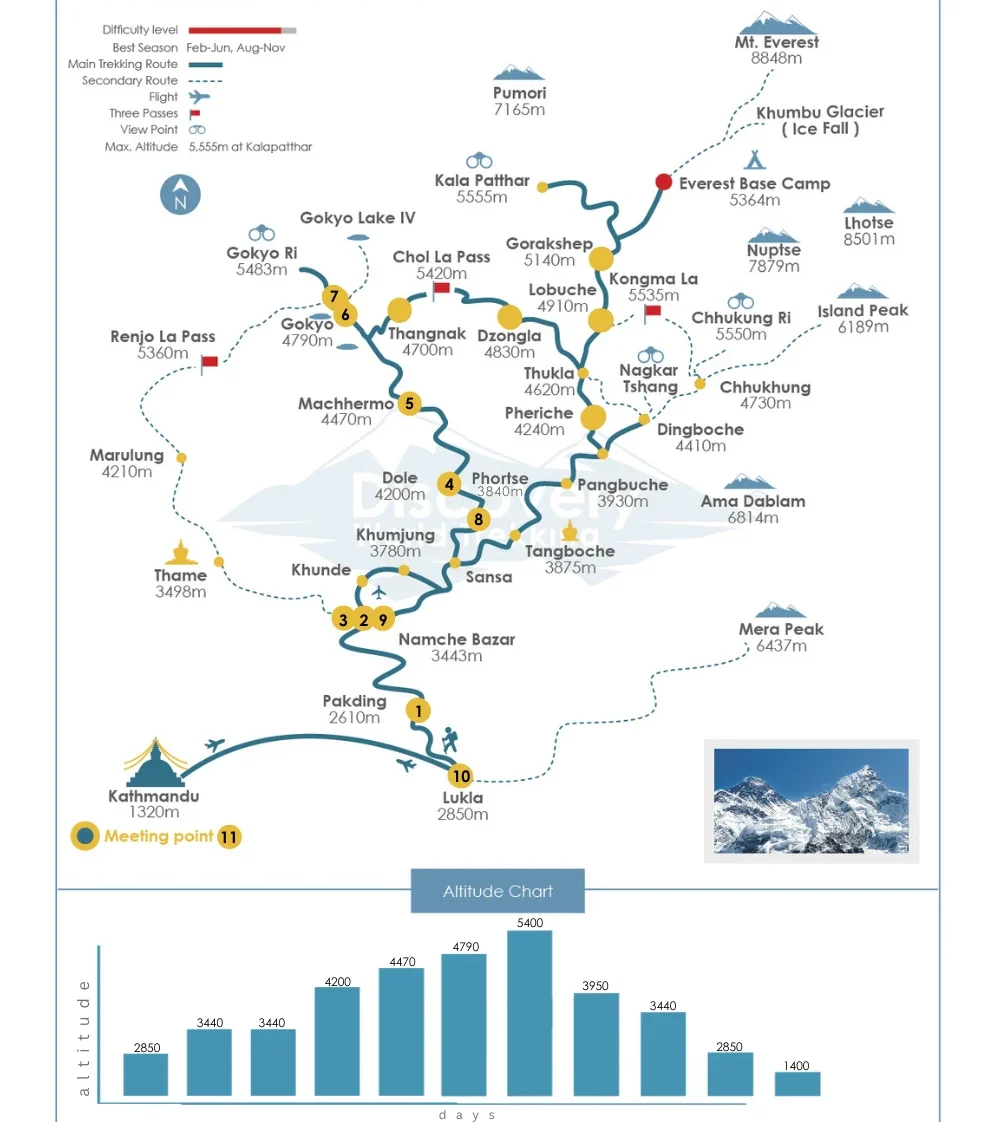
FAQS
Lorem Ipsum is simply dummy text of the printing and typesetting industry. Lorem Ipsum has been the industry’s standard dummy text ever since the 1500s, when an unknown printer took a galley of type and scrambled it to make a type specimen book. It has survived not only five centuries, but also the leap into electronic typesetting, remaining essentially unchanged. It was popularised in the 1960s with the release of Letraset sheets containing Lorem Ipsum passages, and more recently with desktop publishing software like Aldus PageMaker including versions of Lorem Ipsum.
Lorem Ipsum is simply dummy text of the printing and typesetting industry. Lorem Ipsum has been the industry’s standard dummy text ever since the 1500s, when an unknown printer took a galley of type and scrambled it to make a type specimen book. It has survived not only five centuries, but also the leap into electronic typesetting, remaining essentially unchanged. It was popularised in the 1960s with the release of Letraset sheets containing Lorem Ipsum passages, and more recently with desktop publishing software like Aldus PageMaker including versions of Lorem Ipsum.
Traveler Reviews
These full and frank reviews are from travelers who have traveled with Ace the Himalaya previously. The reviews and experiences shown here are from reputable travel websites like TripAdvisor, Google, Facebook, and Trust Pilot, etc.
